AsyncTask的介紹及基本使用方法
關於AsyncTask的介紹和基本使用方法可以參考官方文檔和《Android開發筆記之:深入理解多線程AsyncTask》這裡就不重復。
AsyncTask引發的一個問題
上周遇到了一個極其詭異的問題,一個小功能從網絡上下載一個圖片,然後放到ImageView中,是用AsyncTask來實現的,本身邏輯也很簡單,僅是在doInBackground中用HTTP請求把圖片的輸入流取出,然後用BitmapFactory去解析,然後再把得到的Bitmap放到ImageView中。這個應用是用4.0的SDK開發的,也是運行在4.0上面的。但是有時候下載這張圖片去要用很久很久,甚至要等上幾分鐘。通過調試發現一個令人難以接受的事實:竟然是doInBackground()未及時執行,也就是它並沒有在#execute()調用之後馬上執行,而是等待了很久才得以執行。
神馬情況,難道AsyncTask不是線程,難道不是異步,難道AsyncTask另有內幕?
AsyncTask的內幕
AsyncTask主要有二個部分:一個是與主線各的交互,另一個就是線程的管理調度。雖然可能多個AsyncTask的子類的實例,但是AsyncTask的內部Handler和ThreadPoolExecutor都是進程范圍內共享的,其都是static的,也即屬於類的,類的屬性的作用范圍是CLASSPATH,因為一個進程一個VM,所以是AsyncTask控制著進程范圍內所有的子類實例。
與主線程交互
與主線程交互是通過Handler來進行的,因為本文主要探討AsyncTask在任務調度方面的,所以對於這部分不做細致介紹,感興趣的朋友可以去看AsyncTask的源碼
線程任務的調度
內部會創建一個進程作用域的線程池來管理要運行的任務,也就就是說當你調用了AsyncTask#execute()後,AsyncTask會把任務交給線程池,由線程池來管理創建Thread和運行Therad。對於內部的線程池不同版本的
Android的實現方式是不一樣的:
Android2.3以前的版本,也即SDK/API 10和以前的版本
內部的線程池限制是5個,也就是說同時只能有5個線程運行,超過的線程只能等待,等待前面的線程某個執行完了才被調度和運行。換句話說,如果一個進程中的AsyncTask實例個數超過5個,那麼假如前5個都運行很長時間的話,那麼第6個只能等待機會了。這是AsyncTask的一個限制,而且對於2.3以前的版本無法解決。如果你的應用需要大量的後台線程去執行任務,那麼你只能放棄使用AsyncTask,自己創建線程池來管理Thread,或者干脆不用線程池直接使用Thread也無妨。不得不說,雖然AsyncTask較Thread使用起來比較方便,但是它最多只能同時運行5個線程,這也大大局限了它的實力,你必須要小心的設計你的應用,錯開使用AsyncTask的時間,盡力做到分時,或者保證數量不會大於5個,否則就可能遇到上面提到的問題。要不然就只能使用JavaSE中的API了。
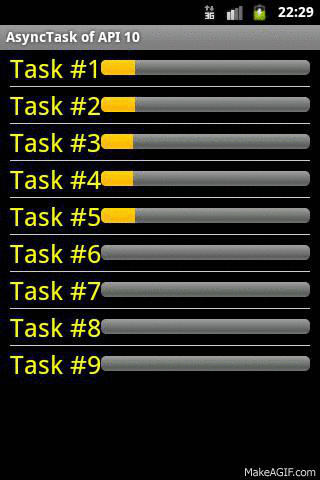
Android 3.0以後,也即SDK/API 11和以後的版本
可能是Google意識到了AsyncTask的局限性了,從Android 3.0開始對AsyncTask的API做出了一些調整:
1.#execute()提交的任務,按先後順序每次只運行一個
也就是說它是按提交的次序,每次只啟動一個線程執行一個任務,完成之後再執行第二個任務,也就是相當於只有一個後台線程在執行所提交的任務(Executors.newSingleThreadPool())。
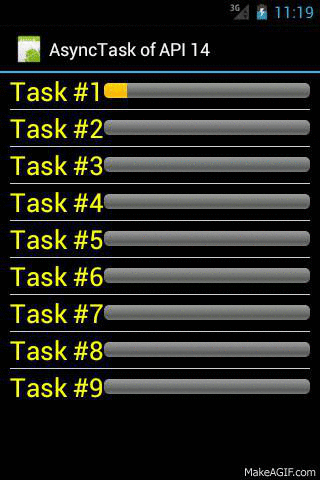
2.新增了接口#executeOnExecutor()
這個接口允許開發者提供自定義的線程池來運行和調度Thread,如果你想讓所有的任務都能並發同時運行,那就創建一個沒有限制的線程池(Executors.newCachedThreadPool()),並提供給AsyncTask。這樣這個AsyncTask實例就有了自己的線程池而不必使用AsyncTask默認的。
3.新增了二個預定義的線程池SERIAL_EXECUTOR和THREAD_POOL_EXECUTOR
其實THREAD_POOL_EXECUTOR並不是新增的,之前的就有,只不過之前(Android 2.3)它是AsyncTask私有的,未公開而已。THREAD_POOL_EXECUTOR是一個corePoolSize為5的線程池,也就是說最多只有5個線程同時運行,超過5個的就要等待。所以如果使用executeOnExecutor(AsyncTask.THREAD_POOL_EXECUTOR)就跟2.3版本的AsyncTask.execute()效果是一樣的。
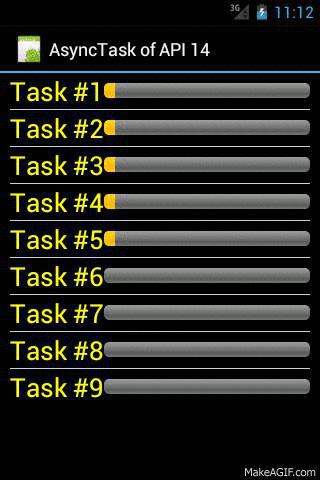
而SERIAL_EXECUTOR是新增的,它的作用是保證任務執行的順序,也就是它可以保證提交的任務確實是按照先後順序執行的。它的內部有一個隊列用來保存所提交的任務,保證當前只運行一個,這樣就可以保證任務是完全按照順序執行的,默認的execute()使用的就是這個,也就是executeOnExecutor(AsyncTask.SERIAL_EXECUTOR)與execute()是一樣的。
前面問題的解法
了解了AsyncTask的內幕就知道了前面問題的原因:因為是4.0平台,所以所有的AsyncTask並不都會運行在單獨的線程中,而是被SERIAL_EXECUTOR順序的使用線程執行。因為應用中可能還有其他地方使用AsyncTask,所以到網絡取圖片的AsyncTask也許會等待到其他任務都完成時才得以執行而不是調用executor()之後馬上執行。
那麼解決方法其實很簡單,要麼直接使用Thread,要麼創建一個單獨的線程池
(Executors.newCachedThreadPool())。或者最簡單的解法就是使用executeOnExecutor(AsyncTask.THREAD_POOL_EXECUTOR),這樣起碼不用等到前面的都結束了再執行。
AsyncTask的使用注意事項
前面的文章曾建議使用AsyncTask而不是使用Thread,但是AsyncTask似乎又有它的限制,這就要根據具體的需求情況而選擇合適的工具,No Silver Bullet。
下面是一些建議:
•改善你的設計,少用異步處理
線程的開銷是非常大的,同時異步處理也容易出錯,難調試,難維護,所以改善你的設計,盡可能的少用異步。對於一般性的數據庫查詢,少量的I/O操作是沒有必要啟動線程的。
•與主線程有交互時用AsyncTask,否則就用Thread
AsyncTask被設計出來的目的就是為了滿足Android的特殊需求:非主線程不能操作(UI)組件,所以AsyncTask擴展Thread增強了與主線程的交互的能力。如果你的應用沒有與主線程交互,那麼就直接使用Thread就好了。
•當有需要大量線程執行任務時,一定要創建線程池
線程的開銷是非常大的,特別是創建一個新線程,否則就不必設計線程池之類的工具了。當需要大量線程執行任務時,一定要創建線程池,無論是使用AsyncTask還是Thread,因為使用AsyncTask它內部的線程池有數量限制,可能無法滿足需求;使用Thread更是要線程池來管理,避免虛擬機創建大量的線程。比如從網絡上批量下載圖片,你不想一個一個的下,或者5個5個的下載,那麼就創建一個CorePoolSize為10或者20的線程池,每次10個或者20個這樣的下載,即滿足了速度,又不至於耗費無用的性能開銷去無限制的創建線程。
•對於想要立即開始執行的異步任務,要麼直接使用Thread,要麼單獨創建線程池提供給AsyncTask
默認的AsyncTask不一定會立即執行你的任務,除非你提供給他一個單獨的線程池。如果不與主線程交互,直接創建一個Thread就可以了,雖然創建線程開銷比較大,但如果這不是批量操作就沒有問題。
•Android的開發沒有想像中那樣簡單,要多花心思和時間在代碼上和測試上面,以確信程序是優質的
附上相關資源:
使用自定義的CorePoolSize為7的Executor(Executors.newFixedThreadPool(7)):
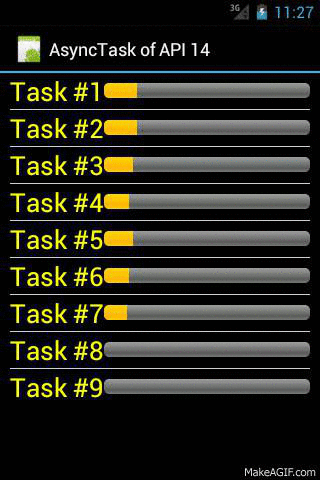
使用未設限制的Executor(Executors.newCachedThreadPool()):
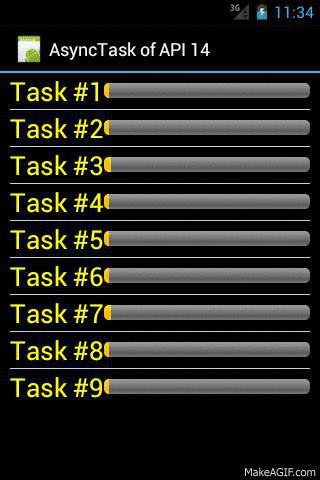
這些例子所用的代碼:
復制代碼 代碼如下:
public class AsyncTaskDemoActivity extends Activity {
private static int ID = 0;
private static final int TASK_COUNT = 9;
private static ExecutorService SINGLE_TASK_EXECUTOR;
private static ExecutorService LIMITED_TASK_EXECUTOR;
private static ExecutorService FULL_TASK_EXECUTOR;
static {
SINGLE_TASK_EXECUTOR = (ExecutorService) Executors.newSingleThreadExecutor();
LIMITED_TASK_EXECUTOR = (ExecutorService) Executors.newFixedThreadPool(7);
FULL_TASK_EXECUTOR = (ExecutorService) Executors.newCachedThreadPool();
};
@Override
public void onCreate(Bundle icicle) {
super.onCreate(icicle);
setContentView(R.layout.asynctask_demo_activity);
String title = "AsyncTask of API " + VERSION.SDK_INT;
setTitle(title);
final ListView taskList = (ListView) findViewById(R.id.task_list);
taskList.setAdapter(new AsyncTaskAdapter(getApplication(), TASK_COUNT));
}
private class AsyncTaskAdapter extends BaseAdapter {
private Context mContext;
private LayoutInflater mFactory;
private int mTaskCount;
List<SimpleAsyncTask> mTaskList;
public AsyncTaskAdapter(Context context, int taskCount) {
mContext = context;
mFactory = LayoutInflater.from(mContext);
mTaskCount = taskCount;
mTaskList = new ArrayList<SimpleAsyncTask>(taskCount);
}
@Override
public int getCount() {
return mTaskCount;
}
@Override
public Object getItem(int position) {
return mTaskList.get(position);
}
@Override
public long getItemId(int position) {
return position;
}
@Override
public View getView(int position, View convertView, ViewGroup parent) {
if (convertView == null) {
convertView = mFactory.inflate(R.layout.asynctask_demo_item, null);
SimpleAsyncTask task = new SimpleAsyncTask((TaskItem) convertView);
/*
* It only supports five tasks at most. More tasks will be scheduled only after
* first five finish. In all, the pool size of AsyncTask is 5, at any time it only
* has 5 threads running.
*/
// task.execute();
// use AsyncTask#SERIAL_EXECUTOR is the same to #execute();
// task.executeOnExecutor(AsyncTask.SERIAL_EXECUTOR);
// use AsyncTask#THREAD_POOL_EXECUTOR is the same to older version #execute() (less than API 11)
// but different from newer version of #execute()
// task.executeOnExecutor(AsyncTask.THREAD_POOL_EXECUTOR);
// one by one, same to newer version of #execute()
// task.executeOnExecutor(SINGLE_TASK_EXECUTOR);
// execute tasks at some limit which can be customized
// task.executeOnExecutor(LIMITED_TASK_EXECUTOR);
// no limit to thread pool size, all tasks run simultaneously
task.executeOnExecutor(FULL_TASK_EXECUTOR);
mTaskList.add(task);
}
return convertView;
}
}
private class SimpleAsyncTask extends AsyncTask<Void, Integer, Void> {
private TaskItem mTaskItem;
private String mName;
public SimpleAsyncTask(TaskItem item) {
mTaskItem = item;
mName = "Task #" + String.valueOf(++ID);
}
@Override
protected Void doInBackground(Void... params) {
int prog = 1;
while (prog < 101) {
SystemClock.sleep(100);
publishProgress(prog);
prog++;
}
return null;
}
@Override
protected void onPostExecute(Void result) {
}
@Override
protected void onPreExecute() {
mTaskItem.setTitle(mName);
}
@Override
protected void onProgressUpdate(Integer... values) {
mTaskItem.setProgress(values[0]);
}
}
}
class TaskItem extends LinearLayout {
private TextView mTitle;
private ProgressBar mProgress;
public TaskItem(Context context, AttributeSet attrs) {
super(context, attrs);
}
public TaskItem(Context context) {
super(context);
}
public void setTitle(String title) {
if (mTitle == null) {
mTitle = (TextView) findViewById(R.id.task_name);
}
mTitle.setText(title);
}
public void setProgress(int prog) {
if (mProgress == null) {
mProgress = (ProgressBar) findViewById(R.id.task_progress);
}
mProgress.setProgress(prog);
}
}
復制代碼 代碼如下:
<?xml version="1.0" encoding="utf-8"?>
<LinearLayout xmlns:android="http://schemas.android.com/apk/res/android"
android:layout_width="match_parent"
android:layout_height="match_parent"
android:paddingLeft="10dip"
android:paddingRight="10dip"
android:orientation="vertical" >
<ListView android:id="@+id/task_list"
android:layout_width="fill_parent"
android:layout_height="wrap_content"
android:divider="#cccccc"
android:dividerHeight="0.6dip"
android:footerDividersEnabled="true"
android:headerDividersEnabled="true" />
</LinearLayout>
復制代碼 代碼如下:
<?xml version="1.0" encoding="utf-8"?>
<com.hilton.effectiveandroid.os.TaskItem xmlns:android="http://schemas.android.com/apk/res/android"
android:layout_width="match_parent"
android:layout_height="50dip"
android:gravity="center_vertical"
android:layout_gravity="center_vertical"
android:orientation="horizontal" >
<TextView android:id="@+id/task_name"
android:layout_width="wrap_content"
android:layout_height="wrap_content"
android:textColor="#ffff00"
android:textSize="26sp" />
<ProgressBar android:id="@+id/task_progress"
android:layout_width="fill_parent"
android:layout_height="15dip"
android:max="100"
/>
</com.hilton.effectiveandroid.os.TaskItem >





 Android程序開發之防止密碼輸入錯誤 密碼明文顯示功能
Android程序開發之防止密碼輸入錯誤 密碼明文顯示功能
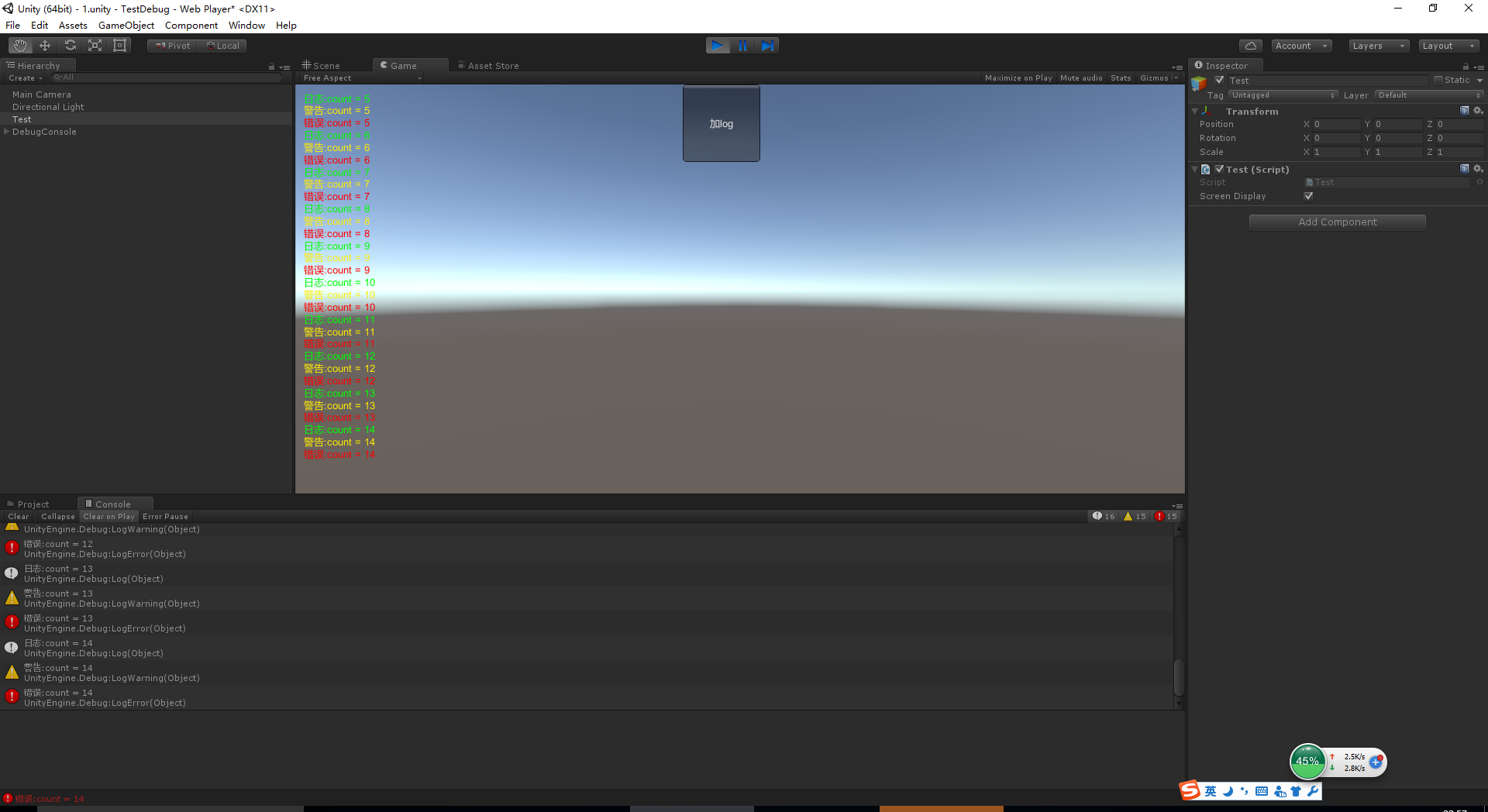 unity 日志系統
unity 日志系統
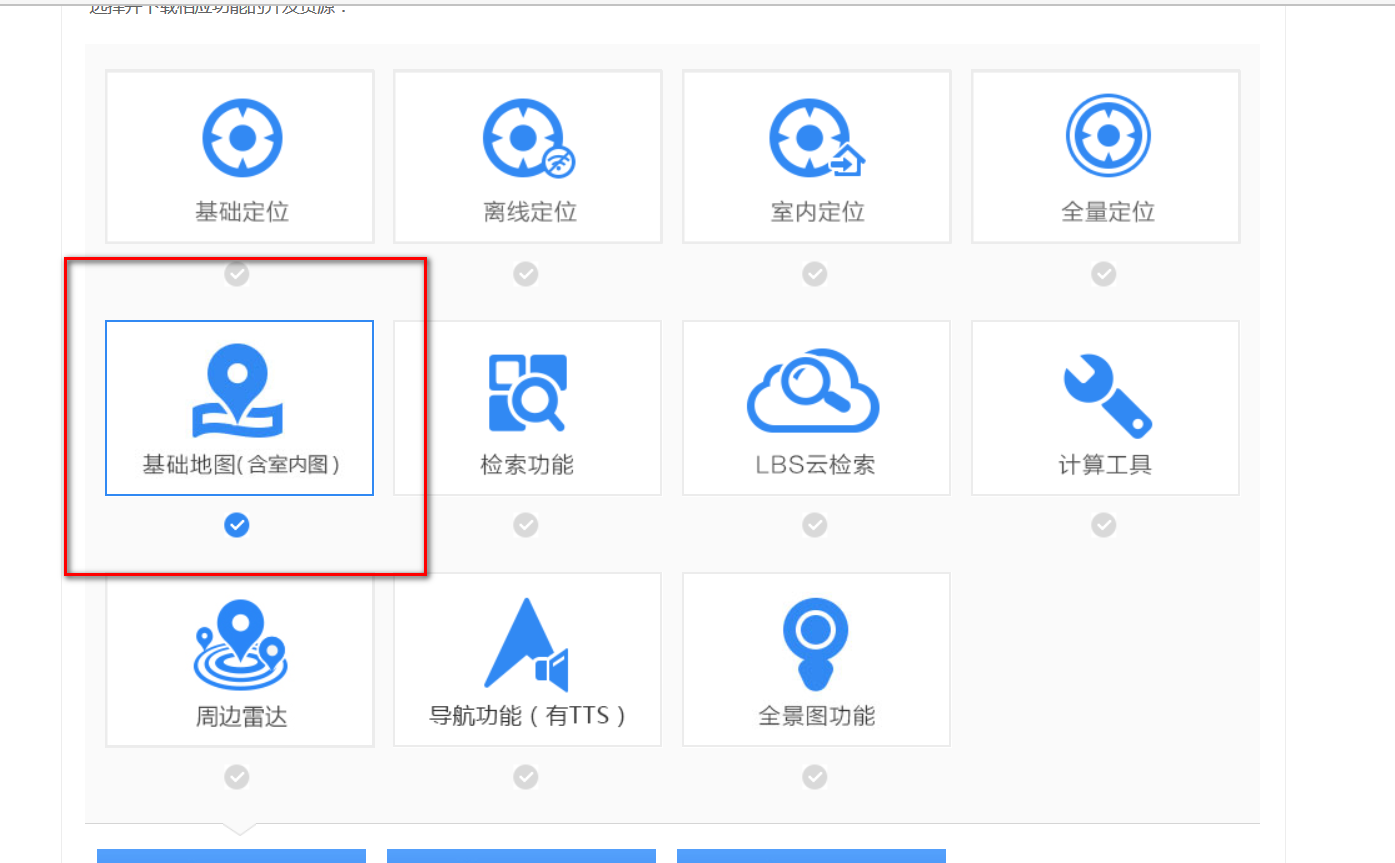 第三方SDK:百度地圖(一)HelloBaiduMap
第三方SDK:百度地圖(一)HelloBaiduMap
 Android studio創建第一個app
Android studio創建第一個app